Top News
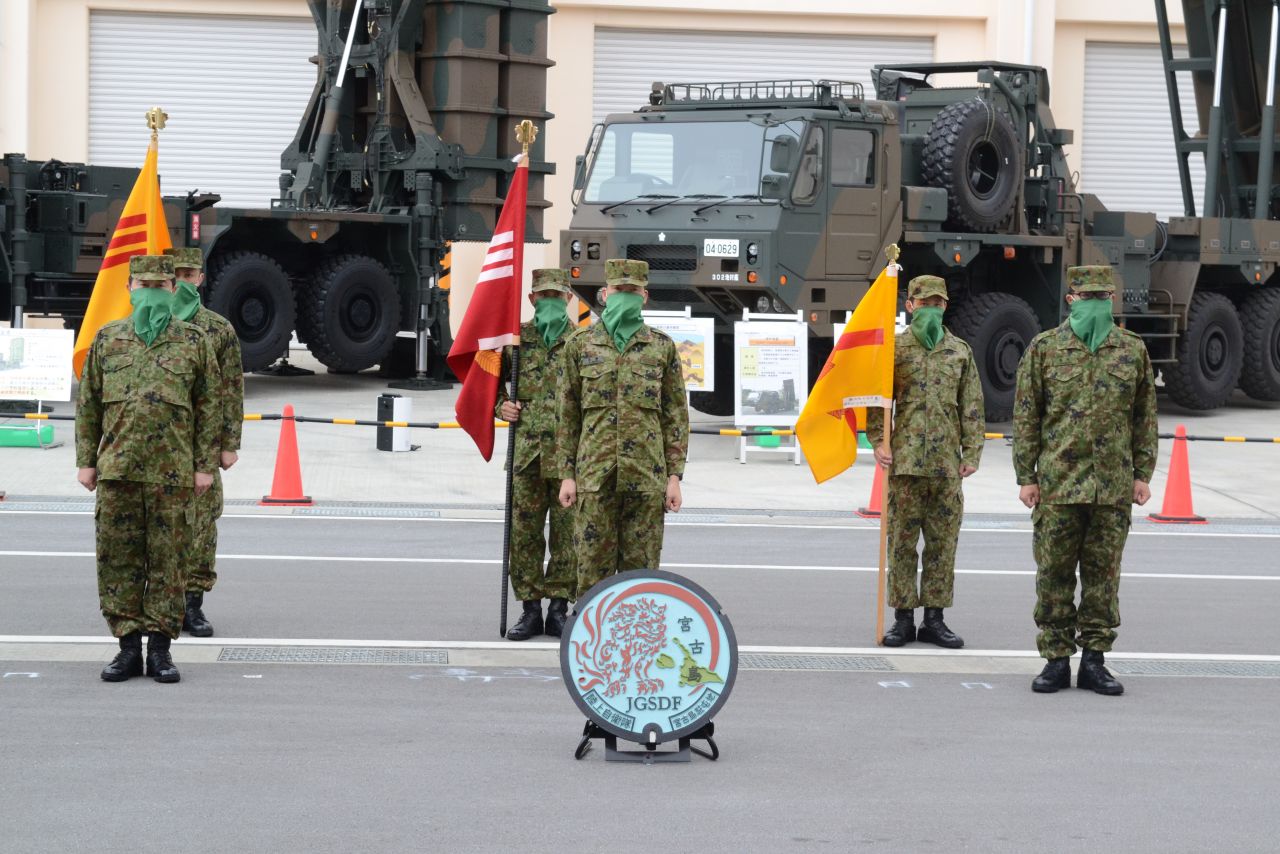
April 5, 2020 Ryukyu Shimpo
Miyako-jima, Okinawa—On April 5, the Japan Ground Self-Defense Force 15th Brigade held a ceremony to conclude the military structuring of Miyako-jima base in Ueno-nobaru, Miyako-jima City. The event was held against requests from the city and the local medical association to delay, given the recent spread of COVID-19. Locals staged a protest outside the main gate of the base, demanding the deployment of forces to stop. They handed a letter of protest to a JGSDF member, stating that they “strongly oppose the military fortification of Miyako-jima, as it brings to the island the dangers of war.”
The base opened in March 2019, where approximately JGSDF 380 members were deployed as the Miyako Area Security Force. In addition, in March of this year, the JSDF’s surface-to-air missile and surface-to-ship missile units, comprising approximately 240 members, were deployed to Miyako, bringing the total number of JGSDF members stationed on the island to approximately 700.
According to the JGSDF in Miyako-jima, vehicles fitted with missile launch pads and other equipment to be used by its units are now mostly installed, with the exception of ammunition.
Commander of Miyako-jima, Colonel (itto rikusa) Shinji Sato said at the ceremony, “The national security environment of our nation is intensifying. Miyako-jima separates the East China Sea from the Pacific Ocean and is a point of strategic importance. It is the frontline in defending the [country’s] southwestern region. We intend to protect the islands, demonstrate the nation’s resolve, and fill the void of military presence in the southwestern region.”
(English translation by T&CT and Monica Shingaki)
Go To Japanese

April 6, 2020 Ryukyu Shimpo
A vital part of shimi in Okinawa, the tomb sweeping festival season, as well as the Bon festival, the peak season for manufacturing “uchikabi,” money for the afterlife, has arrived. Showa Seishi (Uruma), Okinawa’s only manufacturer of uchikabi, was bustling April 3 as its employees were skillfully assembling bundles of the paper money.
A specialized machine imprints small “coin eyes” into the paper, and then cuts it in a relaxed rhythm. In March alone, 110,000 bundles (11 million sheets) were made, and the factory produces about 270,000 sheets per day. These bundles are shipped to stores around Okinawa.
“We are the mint bureau for our ancestors,” says executive sales officer Yasukuni Yakabi, 67, smiling. With the ongoing coronavirus pandemic, there are some who are trying to call off shimi this year. “Even if you do not go to visit the grave, you can still burn the uchikabi at the alter in your house. Even that will please your ancestors,” he said.
(English translation by T&CT and Sam Grieb)
Go To Japanese
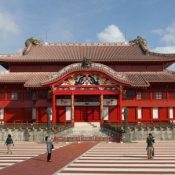
March 27, 2020 Ryukyu Shimpo
On the morning of March 27, the government held a meeting of relevant ministers, headed by Chief Cabinet Secretary Yoshihide Suga, to discuss the restoration of Shuri Castle at the Prime Minister’s official residence. The members of the meeting drew up a schedule aiming to complete restoration of the burned-down main hall of Shuri Castle by 2026. The schedule also includes a plan to install sprinklers in order to prevent another devastating fire.
“We will proceed with the restoration of Shuri Castle’s main hall together with the Okinawa prefectural government, other parties in Okinawa, and experts on the basis of the schedule,” said Suga. The government announced that it will begin discussion of restoring the north hall and south hall as well.
(English translation by T&CT and Sandi Aritza)
Go To Japanese

March 31, 2020 Ryukyu Shimpo
Representatives from 12 economic organizations in Okinawa gathered at the Okinawa Harbor View Hotel in Naha March 31 for a Committee of Okinawan Economic Organizations meeting (Denichiro Ishimine, chair), where they asked Governor Denny Tamaki to enact emergency measures in response to the ongoing coronavirus pandemic.
The written request asked for the following:
1. Increase protection measures at ports and airports, and to secure a stable supply of masks.
2. Financial assistance such as expanding the loan interest subsidy to allow financial institutions to issue zero-interest loans, and establishing an assistance program to help business with fixed costs such as rent and payroll costs.
3. An employment subsidy to aid small businesses who would otherwise be paying out of pocket
4. To take bold economic recovery measures after the situation has subsided in conjunction with the Japanese government’s policies such as gift certificates and shopping events, an increase in public works, and the securing and expansion of flight paths.
Committee chair Ishimine warned that the decrease in tourism demand and the suspension of events has affected not only tourism-industry businesses but the Okinawan economy as a whole, saying, “This has created an extremely harsh business environment in particular for small and medium-size businesses, the screaming voices of these businesses’ continuity being threatened is getting closer.” He called on the governor to make sure of policies to support business continuity and employment preservation as well as policies to revitalize the economy after the outbreak has passed.
Governor Tamaki said in response, “Our entire office is engaged in stopping the spread of this disease. This has had a major effect on small and medium businesses, which make up the majority of businesses in Okinawa. I want to continue pursuing policies that allow these businesses to continue seamlessly.”
(English translation by T&CT and Sam Grieb)
Go To Japanese
March 31, 2020 Ryukyu Shimpo
How should Henoko’s military base construction issue, stemming from the relocation of U.S. Marine Corps Air Station Futenma, be addressed? An expert panel recently provided an answer to this question.
Okinawa prefecture previously formed the “Bankoku Shinryo Conference on U.S. Military Base Issues” (Bankoku Shinryo, literally: bridge between nations) to affect policy. Its chairman, Kyoji Yanagisawa, recently offered a statement to the prefectural government: rather than fixating on the Henoko relocation, the focus should be placed on the phased consolidation and scaling down of U.S. bases in Okinawa, specifically by dispersing them to other prefectures and countries.
The experts of the Bankoku Shinryo Conference pointed to the technical challenges of the ongoing relocation project, such as the soft seabed at Henoko, Nago City, and to the government’s estimation that the project will cost taxpayers 930 billion yen with a timeline exceeding 12 years. The expert members explained that speedy action is required to address the original objective of closing US MCAS Futenma, which was to eliminate the dangers it poses.
The expert panel also pointed out the local protests and the recent changes in the region’s security environment. With China expanding its missile capabilities, the Bankoku Shinryo Conference stated that the geographical advantage of installing bases on Okinawa has diminished and militarily, there is more strategic merit in dispersing U.S. forces.
The group concluded that the prefecture should position itself at the intersection of a detente and confidence building in the Asia-Pacific region. To that point, they requested the formation of a Japan-U.S. joint expert panel and called for active public discourse.
The group did not specify where the base should be dispersed to, and in the narrow sense, their conclusion would not be considered a counterproposal. However, they did provide an alternative course of action to the relocation of USMCAS Futenma to Henoko. This can be seen as a response to Chief Cabinet Secretary Suga Yoshihide’s recent criticism that “the governor [of Okinawa] has not stated how to eliminate the dangers [of Futenma]”.
We applaud the Bankoku Shinryo Committee for taking a pragmatic approach in line with military rationale and U.S. strategy, and for presenting a policy that is more feasible. However, Chairman Yanagisawa’s comment that “this is not an easy task,” confirms that the larger problem lies with Japan rather than the U.S.
In the past, Japan’s key government officials have stated that U.S. military bases cannot be relocated to other prefectures due to “political reasons”, which is a testament to Japan’s institutional discrimination against Okinawa in forcing on to it the military burden.
This is further reinforced by the public attitudes held in the main islands of Japan, where many are uninterested and ignore base-related issues. This systemic practice needs to end; otherwise, affecting policy changes will prove difficult when both the Japanese and U.S. governments have repeated that relocating Futenma base to Henoko is “the only option”.
Previously, the Okinawa Prefectural Assembly adopted a position statement in which it urged nation-wide public discourse on mitigating the prefecture’s U.S. base burden, and finding a solution through democratic means. Given the result of the previous prefectural referendum and the public opinion in Okinawa, the prefectural government should explore and implement various ways to incite public discourse.
On the other hand, there are concerning aspects to the group’s conclusion as well—could alignment with U.S. strategy invite reinforcement of military capabilities in Okinawa? In an effort to contain China, the U.S. has redefined the role of the Marine Corps and has placed even more importance on their presence in Okinawa than before. As it happens, there are plans to install nuclear-capable intermediate missiles on base in Okinawa and throughout Japan.
Even if the Marine Corps were re-distributed out of Okinawa, deployment of offensive missiles to Japan would defeat the purpose of the dispersion. The prefecture must be mindful of this consideration.
Lastly, there needs to be a medium-/long-term vision of how to mitigate Okinawa’s military burden, not just pertaining to the U.S. Marine Corps, but in hosting the Japan Self Defense Forces as well.
(English translation by T&CT and Monica Shingaki)
Go To Japanese
March 27, 2020 Ryukyu Shimpo
Reject all things that beget war.
The tragedy that took the precious lives and wealth of Okinawans must not be forgotten, but passed on. We must renew this promise, to ensure peace in Okinawa.
The Battle of Okinawa began at the end of March in 1945, in which 20 million Japanese and Americans lost their lives.
The U.S. military landed in Zamami Village on March 26, 1945, and in Tokashiki Village on March 27, taking the island groups administered by both villages.
Coming under U.S. fire, approximately 500 locals committed “shudan jiketsu” (compulsory mass suicide) as coerced and instructed by the Imperial Japanese Army.
Indeed, the most tragic event in the Battle of Okinawa happened in the early stages of the battle.
The strategy of the Imperial Army was to draw out the war, as to stall what would have been a decisive battle fought on the main islands of Japan.
This strategy came at a tremendous cost to Okinawans.
What Okinawans learned from the Battle of Okinawa is that the military does not protect the lives of the local population.
Their experiences left the islanders with this lesson: the military and local civilians are at opposing ends from one another.
For Okinawans seeking peace, these lessons underlie their quest.
However, there has been a movement to deny these accounts, which should not be glossed over.
In 2006, during the government’s authorization review of school textbooks, comments were made to obfuscate the Imperial Army’s “coercion and involvement” in the mass suicides, distorting the description of these events.
After Okinawans protested, some of the original articulation was brought back.
Still, those comments made in the authorization review have yet to be retracted.
Ergo, every time the government reviews textbooks for authorization, we pay close attention to the descriptions of the Battle of Okinawa.
On March 24, the Ministry of Education, Culture, Sports, Science and Technology announced their authorization of school textbooks, which will be used in middle schools starting the 2021 school year.
Out of the seven publishers that received authorizations, six mentioned the “shudan-jiketsu” mass suicides in their history textbooks but sadly did not point out any coercion.
On the other hand, some textbooks offered “feature pages” dedicated to detailing the Battle of Okinawa.
While such efforts are commendable, we must continue to keep a watchful eye, to ensure no accounts are distorted.
The presence of the Japan Ground Self Defense Force in the Sakishima Islands also requires close attention, as it goes against the lessons we have learned from the Battle of Okinawa.
The JGSDF base on Miyakojima City received vehicles fitted with surface-to-ship missile launch pads, against local protests.
Meanwhile, the Ishigaki City Council passed a bill to sell city-owned land to the Okinawa Defense Bureau, ignoring the residents’ requests for a referendum to vote on hosting the JGSDF.
Neither actions respect public opinion.
In the year before the Battle of Okinawa, the presence of the Imperial Army meant forceful seizure of private lands and homes, and public facilities, including schools.
Furthermore, the Japanese Army was able to set up military camps and airfields by mobilizing all local residents.
The prefectural and municipal governments had begun to bear the earmarks of a wartime government.
The presence of the Japanese Army bases lead to the tragedy of the Battle of Okinawa.
Given this past, we must make judgments on the appropriateness of the JGSDF deployment to Ishigaki Island.
To grasp the current state of the prefecture and to decide our path forward, we must re-visit as many times as necessary the memories of the Battle of Okinawa—the genesis of post-war Okinawa.
This is the path to a peaceful future for our islands.
(English translation by T&CT and Monica Shingaki)
Go To Japanese
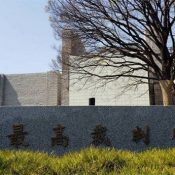
March 26, 2020 Ryukyu Shimpo
Regarding construction of the Futenma replacement facility in Henoko, Nago City as part of relocating MCAS Futenma, Okinawa’s lawsuit requesting cancellation of the Land Minister’s decision to cancel the Okinawa Prefectural Government (OPG)’s revocation of permission for land reclamation, based on the claim that the Minister’s decision is illegal, was dismissed at its final appeal to the Supreme Court First Bench (Judge Takuya Miyama presiding) at 3:00 p.m. on March 26.
This ruling upheld the Fukuoka High Court Naha Branch’s ruling that the Okinawa Defense Bureau (ODB)’s use of the Administrative Appeal act as a “private citizen” was not illegal, and the OPG has lost its lawsuit.
The Administrative Appeal Act is meant to protect the legal rights and interests of private citizens.
In August 2018, the OPG revoked its previous land reclamation permission on the basis of, inter alia, the discovery of soft ground on the Oura Bay side of the planned area for land reclamation.
The ODB lodged a formal objection, based on the Administrative Appeal Act, to the OPG’s revocation, and Land Minister Keiichi Ishii made the decision to cancel the OPG’s revocation.
The OPG claimed that this decision was an abuse of the system and illegal, and the “Committee for Settling National-Local Disputes”, a third-party entity of the Ministry of Internal Affairs, investigated the matter but rejected the OPG’s claim, and then the OPG filed a lawsuit addressing this matter in July 2019.
In October, the case was first seen in the Fukuoka High Court Naha Branch, the OPG’s claim was rejected, and the OPG has now lost the case.
The OPG has separately filed another lawsuit seeking cancellation, based on the Administrative Litigation Act, of the ruling and this lawsuit is currently being contested in the Naha District Court.
(English translation by T&CT and Erin Jones)
Go To Japanese
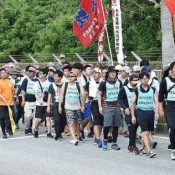
March 25, 2020 Ryukyu Shimpo
On March 25 the Okinawa Peace Movement Center (Chairman Hiroji Yamashiro) held an action committee meeting, at which it was decided that the 43rd 5/15 Peace March would be cancelled.
This is the first time the peace march has been cancelled. The rally, which was to be held on the final day of the event, was also cancelled. These actions were taken as measures to prevent the spread of the novel coronavirus.
In 2011, when the Great East Japan Earthquake struck, the scale of the event was reduced.
The 5/15 Peace March is held every year to draw attention to the importance of peace. The event spans 3 days, falling around May 15 when Okinawa was returned to mainland Japan.
During the event, participants from both within Japan and overseas gather to march in various places in Okinawa, the marches being mainly centered in the surroundings of U.S. military bases and the old battlefields from the Battle of Okinawa.
(English translation by T&CT and Erin Jones)
Go To Japanese
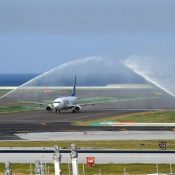
March 26, 2020 Ryukyu Shimpo
Naha Airport’s No. 2 runway, built by filling in land off the coast, opened for use March 26.
The runway’s first arrival, a flight from Skymark Airlines, touched down at 8:05 a.m., and was greeted by a water arch provided by a pair of firetrucks on either side.
Runway No. 2 runs 2,700 meters in length, with a width of 60 meters. The completion of the new runway will increase the annual flight capacity of Naha Airport from 135,000 to 240,000.
Now, Okinawa will look to establish new air routes with the domestic and international airlines they do business with, increasing the flow of people and goods through the island, which is expected to lead to further growth for the Okinawan economy.
Due to the continued spread of COVID-19, recently there have been a reduction in the number of flights as well as outright suspension of some routes, making for a harsh environment for the opening of the runway, however Okinawa Prefecture and economic organizations plan to strengthen their promotional push once the situation as subsided.
(English translation by T&CT and Sam Grieb)
Go To Japanese
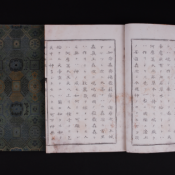
March 19, 2020 Ryukyu Shimpo
On March 19, Japan’s Council for Cultural Affairs made a recommendation to Koichi Hagiuda, the minister of Education, Culture, Sports, Science and Technology, to designate the official history books of the Ryukyu Kingdom—the Chuzan Seikan (six volumes), Chuzan Seifu: Sai Taku Edition (7 volumes), and Chuzan Seifu: Sai On Edition (12 volumes), as an Important Cultural Property of Japan (“calligraphy and books” category).
The ministry is expected to announce the designation as recommended, by this summer.
It will be the third Okinawan artifact to earn the designation in the “calligraphy and books” category, following the designation of the Omorososhi (a collection of ancient Ryukyuan songs) and the Konnkou Kennsyuu (ancient dictionary of the indigenous Ryukyu language).
The three books, considered a single unit, are highly valued in Ryukyuan history research as the most important texts.
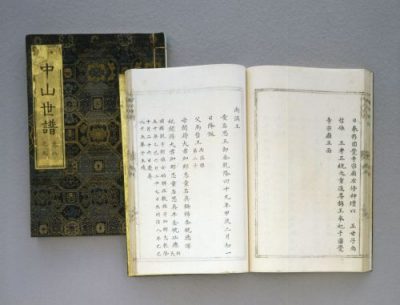
Chuzan Seifu: Sai Taku Edition (photograph provided by the Okinawa Prefectural Museum & Art Museum)
The Chuzan Seikan is a Ryukyuan history book compiled in 1650 by the Ryukyuan politician and regent, Sho Shoken (also known as Choshu Haneji) by order of the king, Sho Shitsu. It is written in Japanese.
Chuzan Seifu is a Ryukyuan history book with two versions, written in Chinese.
The seven volumes in the Sai Taku edition is an expanded version of the Chuzan Seikan, edited and translated into Chinese in 1697-1701 by Sai Taku, who served in the most powerful official post of Kume Village.
The Sai On edition was compiled in 1724-1725 by Sai On, son of Sai Taku, with further modifications.
All three designated articles were taken to the United States during the turmoil of the Bat
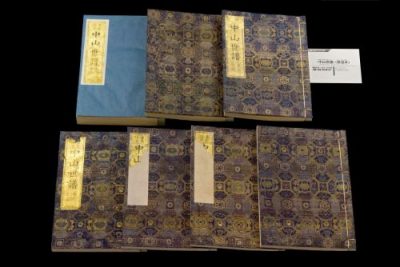
Chuzan Seifu: Sai On Edition (photograph provided by the Okinawa Prefectural Museum & Art Museum)
tle of Okinawa and were returned to the Ryukyu government after the war.
Shojin Heshiki, head of the Prefectural Board of Education, commented on the Important National Cultural Property designation: “I am thrilled.
The Prefectural Board of Education will continue to work with the Okinawa Prefectural Museum & Art Museum to promote the preservation and education of cultural properties.”
(English translation by T&CT and Monica Shingaki)
Go To Japanese
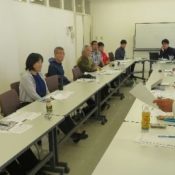
March 22, 2020 Ryukyu Shimpo
On March 21, former members of the “Henoko” Prefectural Referendum Association, who directly petitioned for the holding of the prefectural referendum in February 2019 on whether residents supported or opposed the land reclamation in Henoko, Nago as part of the relocation of U.S. Marine Corps Air Station Futenma, held a meeting in Naha to discuss their plans going forward.
At the meeting, the members decided to petition the prefectural government to re-revoke the land reclamation permit on the grounds that the referendum result offers new grounds for revocation and to go on a nationwide tour visiting Japan’s other 46 prefectures.
They plan to meet with Governor Denny Tamaki soon and deliver a letter of petition to him.
Jinshiro Motoyama, who served as representative as the association, said, “respecting the result of the referendum must be discussed in more depth in Okinawa, and we must also see that the rest of Japan turns an eye back to the matter as well.”
The group’s petition will make five requests of the prefectural government: (1) to re-revoke the land reclamation permit at an appropriate timing, (2) to carry out a nationwide tour to the other 46 prefectures of Japan, (3) to carry out immediate action in Tokyo, (4) to cancel the Henoko new base construction and to have the Prefectural Assembly adopt a statement declaring that the relocation of U.S. Marine Corps Air Station Futenma outside of Okinawa or outside Japan should be resolved fairly and democratically on the basis of nationwide debate, and call for such nationwide debate, and (5) to request that the National Governors’ Association adopt the statement.
The meeting was attended by fifteen former members including representatives who called for the referendum to be held.
Regarding their hope that the prefectural government re-revoke the land reclamation permit on the grounds that the referendum provides new justification for revocation, members at the meeting voiced opinions such as, “re-revocation would have the effect of stopping the construction,” and “it would show a stance of moving forward together in a manner in line with public opinion and provide an opportunity for open debate.”
Regarding the action in Tokyo, members’ voiced opinions such as, “we can’t resolve the problem unless we gain the understanding of people all over Japan,” and “it’s important for people to recognize that there is a colonial arrangement [behind the concentration of bases in Okinawa].”
(English translation by T&CT and Sandi Aritza)
Go To Japanese











 Webcam(Kokusai Street)
Webcam(Kokusai Street)


